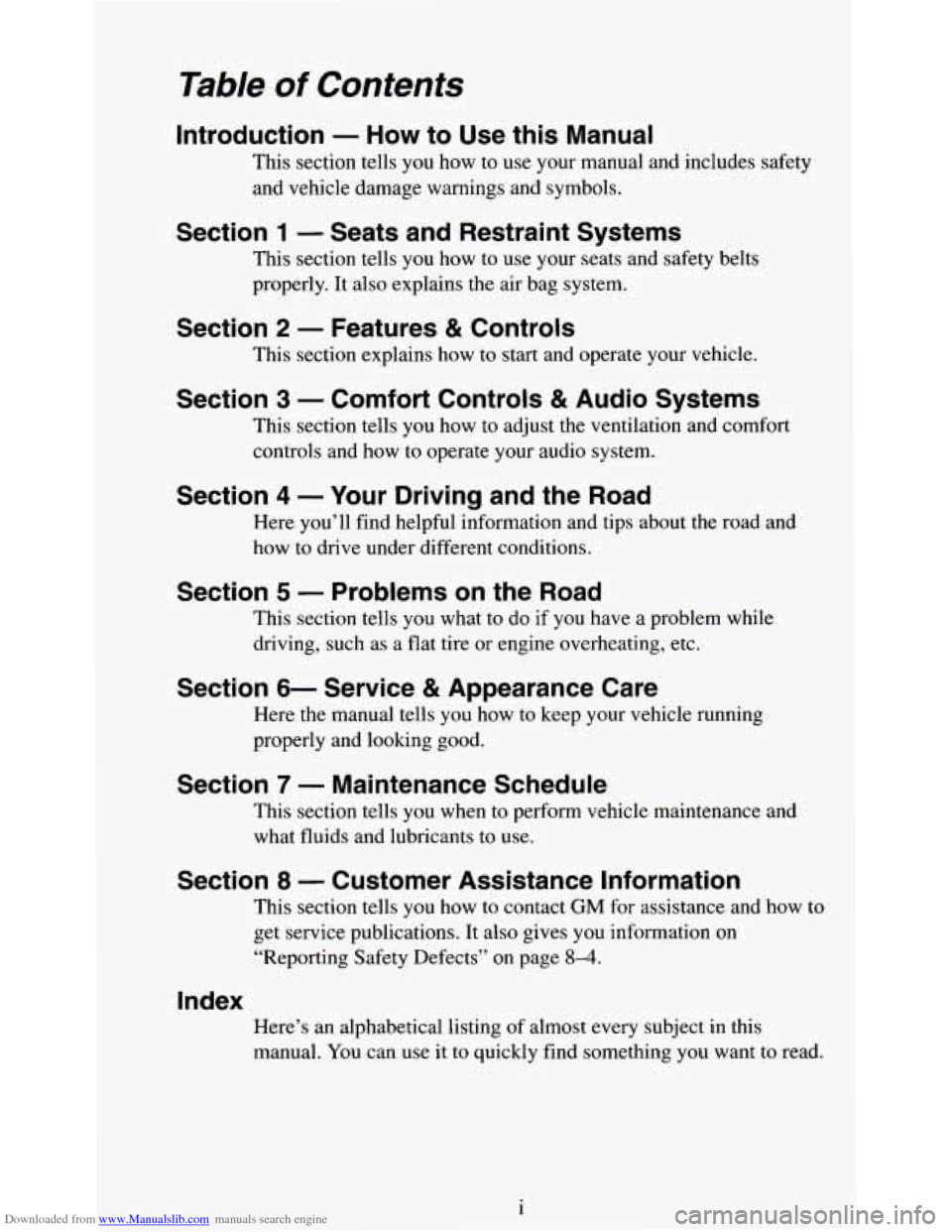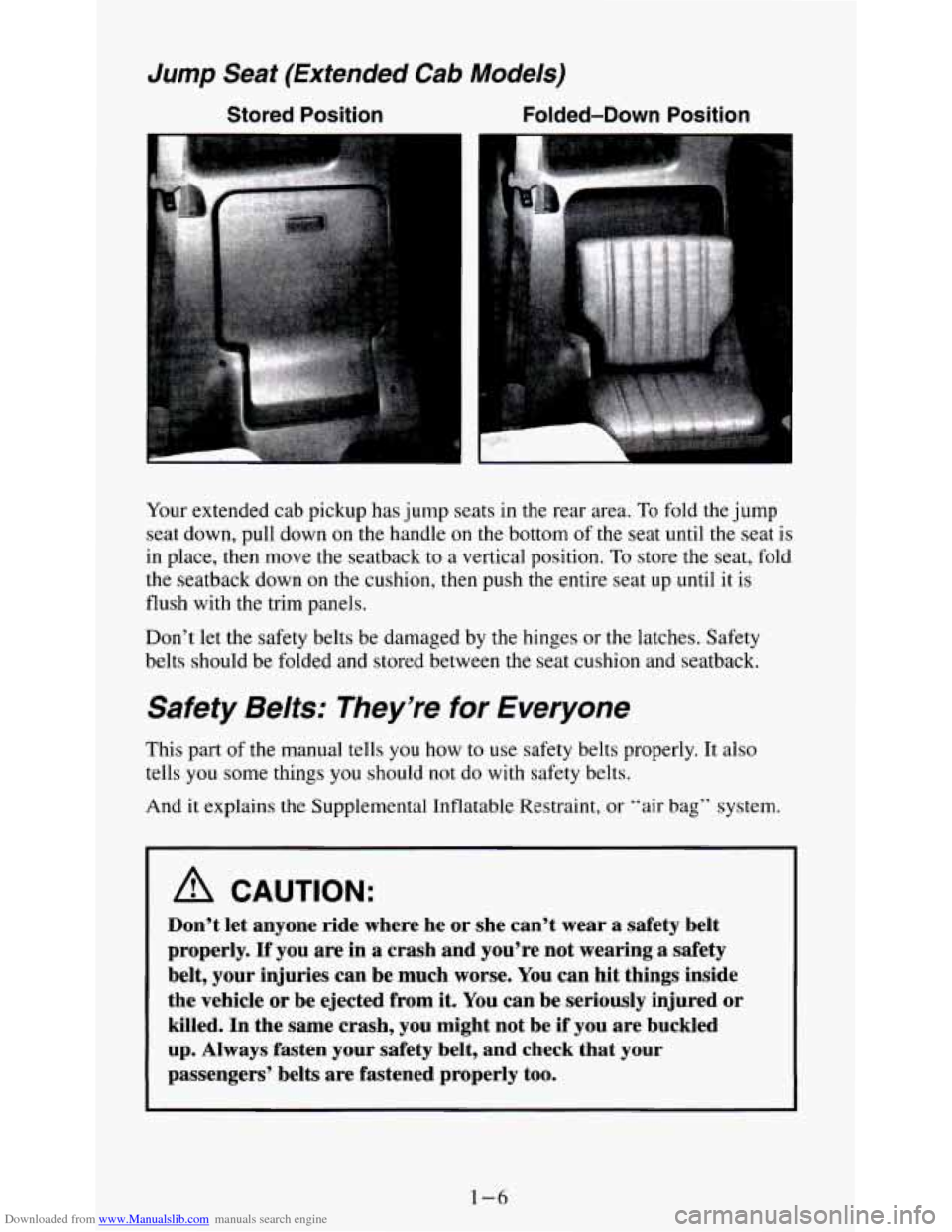Page 2 of 354

Downloaded from www.Manualslib.com manuals search engine Table of Contents
Introduction - How to Use this Manual
This section tells you how to use your manual and includes safety
and vehicle damage warnings and symbols.
Section 1 - Seats and Restraint Systems
This section tells you how to use your seats and safety belts
properly. It also explains the air bag system.
Section 2 - Features & Controls
This section explains how to start and operate your vehicle.
Section 3 - Comfort Controls & Audio Systems
This section tells you how to adjust the ventilation and comfort
controls and how to operate your audio system.
Section 4 - Your Driving and the Road
Here you’ll find helpful information and tips about the road and
how to drive under different conditions.
Section 5 - Problems on the Road
This section tells you what to do if you have a problem while
driving, such as a flat tire or engine overheating, etc.
Section 6- Service & Appearance Care
Here the manual tells you how to keep your vehicle running
properly and looking good.
Section 7 - Maintenance Schedule
This section tells you when to perform vehicle maintenance and
what fluids and lubricants to use.
Section 8 - Customer Assistance Information
This section tells you how to contact GM for assistance and how to
get service publications. It also gives you information on
“Reporting Safety Defects” on page
8-4.
Index
Here’s an alphabetical listing of almost every subject in this
manual. You can use it to quickly find something you want to read.
1
Page 10 of 354
Downloaded from www.Manualslib.com manuals search engine Seats & Restraint Systems
Section
Here you’ll find information about the seats in your vehicle and how to use
your safety belts properly. You can also learn about some things you should
not do with air bags and safety belts.
Seats and Seat Controls
This section tells you about the seats-how to adjust them, and fold them up
and down.
Front Seat (Except Easy Entry)
1 A CAUTION:
You can lose control of the vehicle if you try to adjust a manual
driver’s seat while the vehicle is moving. The sudden movement
could startle and confuse
you, or make you push a pedal when
you don’t want to. Adjust the driver’s seat
only when the vehicle
is not moving.
1-1
Page 11 of 354
Downloaded from www.Manualslib.com manuals search engine r
Move the lever under
the front
of the seat
towards the driver’s door to unlock it.
Slide the seat to where
you want it. Then
release the lever and
try to move the seat
with your body to
make sure the seat is
locked into place.
Front Seat (Easy Entry Only)
Move the lever under
the front
of the seat up
to unlock it. Slide the
seat to where you
want it. Then release
the lever and
try to
move the seat with
your body to make
7 sure the seat is locked
into place.
If you have this
feature, there will be a
knob
on the outside of
the driver and
passenger bucket seats.
Turn the top of the
knob forward to
increase
lumbar
support or rearward to
decrease lumbar
support.
1-2
Page 12 of 354
Downloaded from www.Manualslib.com manuals search engine Reclining Front Seatbacks (Bucket Seats or 60/40
Bench)
To adjust the seatback,
lift the lever on the
outer side
of the seat.
Release the lever
to
lock the seatback
where you want it.
Pull up on the lever
and the seat will
go to
an upright position.
But don’t have a seatback reclined if your vehicle is moving.
1-3
Page 15 of 354

Downloaded from www.Manualslib.com manuals search engine Jump Seat (Extended Cab Models)
Stored Position Folded-Down Position
Your extended cab pickup has jump seats in the rear area. To fold the jump
seat down, pull down
on the handle on the bottom of the seat until the seat is
in place, then move the seatback to a vertical position.
To store the seat, fold
the seatback down
on the cushion, then push the entire seat up until it is
flush with the trim panels.
Don’t let the safety belts be damaged by the hinges
or the latches. Safety
belts should be folded and stored between
the seat cushion and seatback.
Safety Belts: They’re for Everyone
This part of the manual tells you how to use safety belts properly. It also
tells you some things
you should not do with safety belts.
And it explains the Supplemental Inflatable Restraint, or
“air bag” system.
A CAUTION:
Don’t let anyone ride where he or she can’t wear a safety belt
properly.
If you are in a crash and you’re not wearing a safety
belt, your injuries can be much worse. You can hit things inside
the vehicle or be ejected from it. You can be seriously injured or
killed. In the same crash,
you might not be if you are buckled
up. Always fasten your safety belt, and check that your
passengers’ belts are fastened properly too.
Page 20 of 354
Downloaded from www.Manualslib.com manuals search engine 2. Adjust the seat (to see how, see “Seats” in the Index) SO YOU can sit UP
straight.
3. Pick up the latch
plate and pull the
belt across
you.
Don’t let it get
twisted.
I
4. Push the latch plate into the buckle until it clicks.
Pull
UP on the latch plate to make sure it is secure.
If the belt isn’t long enough, see “Safety Belt Extender” at the end of
this section.
Make sure the release button on the buckle is positioned
so you would
be able to unbuckle the safety belt quickly if
you ever had to.
5. To make the lap
part tight, pull
down on the
buckle end
of the
belt as
you pull
up on the
shoulder belt.
1-11
Page 32 of 354
Downloaded from www.Manualslib.com manuals search engine When you sit in a center seating position, you have a lap safety belt, which
has
no retractor. To make the belt longer, tilt the latch plate and pull it along
the belt.
I
Buckle, position and release it the same way as the lap part of a
lap-shoulder belt. If the belt isn’t long enough, see “Safety Belt Extender”
at the end
of this section.
Make sure the release button on the buckle is positioned
so you would be
able to unbuckle the safety belt quickly
if you ever had to.
Rear Seat Passengers (Extended Cab Jump
Seats)
Lap Belt
These are reserve seating positions equipped with lap belts only.
It’s very important for rear seat passengers to buckle up! Accident statistics
show that unbelted people in the rear seat
are hurt more often in crashes
than those who are wearing safety belts.
1-23
Page 34 of 354
Downloaded from www.Manualslib.com manuals search engine a.
To make it shorter, pull the belt as shown until it is snug. Buckle and
position
it the same way as the lap part of the driver’s safety belt (see
“Driver Position” in the Index). Make sure the release button on the buckle
is positioned
so you would be able to unbuckle the safety belt quickly if you
ever had to. To unlatch the belt, just push the button on the buckle.
Don’t use child restraints on these seats. They won’t work properly.
Children
Everyone in a vehicle needs protection! That includes infants and all
children smaller than adult size. In fact, the law in every state in the United
States and in every Canadian province says children up to some age must be
restrained while in a vehicle.
Smaller Children and Babies
1-25